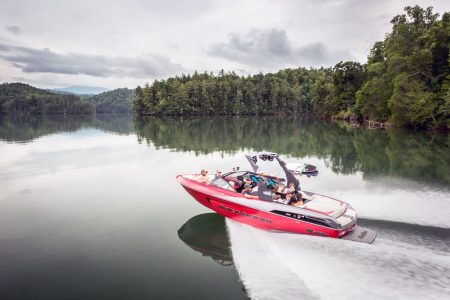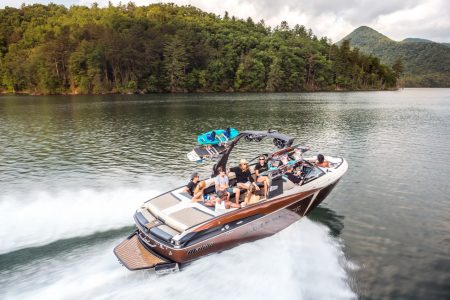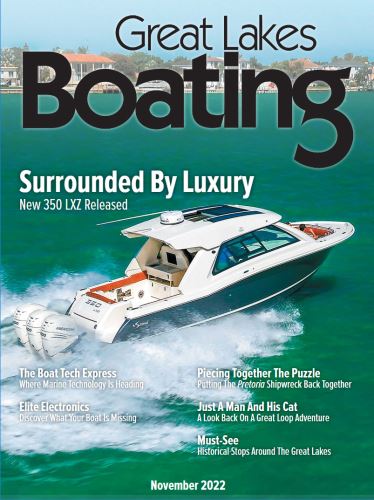By Scott Guthrie It was 24 years ago that my dad took me out on our first father-son boating trip. We drove an hour from our suburban Kansas home to Lake Perry in southeast Missouri. While walking along the dock to our pontoon boat, we stopped at the bait shack to feed the carp, grab some worms and stock up on ice cold Coca-Cola. We loaded up the boat, reversed out of the slip and hit the open water until the sun rested on the waves. I sat on my dad’s lap the entire time, helping him navigate to different coves where we would anchor, rig up some fishing rods, and wait for the catfish to bite. Driving home that day, I remember thinking I would be a boater the rest of my life. I am a 29-year-old Millennial and that is how I was first introduced to boating. From a young age, I was able to experience the boating lifestyle, along with the family and friendship bonds it can create. Being exposed to boating early in life, however, makes me a minority among my generation. Most Millennials (those between the ages of 18-34) weren’t exposed to boating as youngsters, and still haven’t been today. This poses a vexing problem for the American boating industry.

Photo courtesy of Malibu Boats
The Issue For decades, the recreational boating industry has relied on Baby Boomers (those born between 1946-1964), and their checkbooks to keep the industry afloat. It has depended on the members of America’s wealthiest generation to spend part of their discretionary income on boating and fishing. At present, Boomers still have the time and money to go boating, but this won’t last forever. As Boomers grow older, who will take their place? Boating is hoping that Millennials (those between the ages of 18 to 34) are the answer. They are America’s largest generation with an estimated population of 83.1 million and account for more than a quarter of the nation’s population, according to U.S. Census Bureau. From a numbers standpoint, Millennials could easily fill the void Boomers will create, but that’s easier said than done. Despite being on track to become the most educated generation in American history, (In 2013, 47 percent of adults ages 25-34, had a post-secondary degree according to the White House Council of Economic Advisors) Millennials haven’t reaped the assumed economic advantages that come with advanced education. In fact, it appears that just the opposite is true. In 2013, total outstanding U.S. student debt surpassed $1 trillion. The number of college graduates returning home to live because they either can’t find a job or are in dire financial straits is staggering. According to the Census Bureau, the average annual income for Millennials is roughly $34,000, and nearly 20 percent of Millennials live in poverty. This is certainly not good news for an industry that is going to rely on Millennials to keep the industry thriving into the foreseeable future. These financial burdens mean Millennials aren’t buying boats. That’s a problem, but there’s a more fundamental reason why Millennials not buying boats: they’re simply not interested in recreational boating and sportsfishing. That’s because a lot of Millennials have no history of boating to lead them to buy a boat, or even try boating. If Millennials aren’t exposed to boating, it appears they won’t put boat buying on their “to do” list when they reach their prime spending age.

Photo courtesy of Malibu boats
The effort For boating to become relevant for Millennials, it must reach out to them and show them the value of recreational boating through strategic marketing. It must tell Millennials that boating is not a hassle, but rather a stress reliever. It must show them what it showed me all those years ago: that boating is a way to experience nature, socialize and create lifelong memories with loved ones. In short, boating has to do a better job of promoting the boating lifestyle. For decades, boating has relied on one generation to pass down the boating lifestyle to the next generation. That’s how I learned. But this won’t work for most Millennials, because the basic assumption for this model, that is, the traditional, stable family model of husband, wife, and kids has changed. Only 46 percent of kids under the age of 18 live in a home with two heterosexual parents in their first marriage, according to a 2014 Pew Research Study. If the industry can’t rely on parents passing on their passion for and enjoyment of the boating lifestyle, how can Millennials be introduced to boating? The answers are not overwhelmingly obvious, but there are several out there. Boat clubs are one answer. Most boat clubs operate as monthly membership based organizations that allow members access to a fleet of boats at any time. For a monthly fee, a member can take out a boat whenever he or she desires but doesn’t have to worry about incurring the additional costs of owning boat. Boats clubs are great ways to introduce boating to those who want to boat, but do not have the resources to buy a boat. Boat rental companies (which offer one-time rentals) and peer-to-peer boating (owners renting their boat to interested parties) are also options. These types of “on-demand”rental programs are starting to appear around the country. These are an attractive option for Millennials, who value experiences over the ownership of goods. Valuing experiences over goods has led to Millennials being incorrectly labeled as frugal, but Millennials aren’t afraid to spend money. Trust me, I am one of them. We spend money like it’s burning a hole in our pocket. Millennial spending in the U.S. accounts for $1.3 trillion, $430 billion of which is discretionary spending, according to a study by Boston Consulting Group (BCG). If boat companies want Millennials to buy their products, they need to make more affordable models, with features that satisfy their technological appetites, and desires for adventure. A few companies are starting to do this. In September, Bryant Boats launched a new boat?the Wake Tractor?described as specifically designed for Millennials. The 18-foot boat with room for six and a price tag of $39,000 has WiFi and Bluetooth capabilities. It is also driven from a smart tablet that has attachments for GoPro cameras. Wake surfing is also popular among Millennials. Boat manufacturers Tige and Malibu have taken notice. In September 2014, Tige released its Surf Link Remote. Using the remote, users can determine the size and shape of their wave. Nautique Boats has a similar remote wave control product. It has also released an app for the Pebble smart watch. The app lets users control the music on the boat while they wake surf. Malibu unveiled a rearview camera in 2015, allowing the driver to track riders and dock more easily.

Photo courtesy of Malibu Boats
Assessment Boat clubs and rentals, as well as products geared toward Millennials do no good if Millennials don’t know they exist. The responsibility for this lies with boat manufacturers and national organizations, most notably the National Marine Manufactures Association (NMMA). They need to rethink their traditional marketing strategies. These organizations need to realize that sponsoring boat shows and conferences is not the best way to engage Millennials. There are far more effective ways. They need to go where Millennials are. When was the last time you saw a boat company or national organization sponsor a music festival, visit a college, or storm a coffee shop and provide Millennials with an all inclusive day on the water? From my Millennial viewpoint, the boating industry needs to spend more money and do a better job of spreading the word about the benefits of recreational boating to Millennials. The NMMA, the industry’s largest trade association whose self-described focus is to keep recreational boating vital, is the logical leader in this area. It has established a “Discover Boating” campaign, but it needs to do more to entice Millenials into boating. The federal government could get more involved. The U.S. Senate recently reauthorized the Sport Fish Restoration Act for another six years. The act will reauthorize the Sport Fish Restoration and Boating Trust Fund, which is crucial for anglers and fishery resources. It delivers millions of dollars collected each year from boating fuel taxes to states’ fishing and boating programs. In this effort, the government must reexamine how this money is being spent and look at ways to aggressively promote boating and fishing to America’s younger generations. Along similar lines, boating needs to target social groups instead of life stages. Because Millennials face such economic hardships, they have stronger ties to social identities rather than life stages, like buying a house or boat. According to marketing company SocialChorus, 95 percent of Millennials say their friends are the most credible source of product information. If brands can effectively market themselves to Millennials and make a positive impression, they will have a better chance of securing Millennials’ business later in life. Recreational boating is a changing industry, but it doesn’t have to fade out along with the Baby Boomers. Boating needs to target and aggressively pursue its new customers. That includes Millennials, but also Hispanics, African Americans and other non-white sectors, those groups that might not have had the opportunity to experience boating as a child. Millennials live for the type of social experiences boating can offer. Boating just needs to do a better job of making Millennials aware of it.

